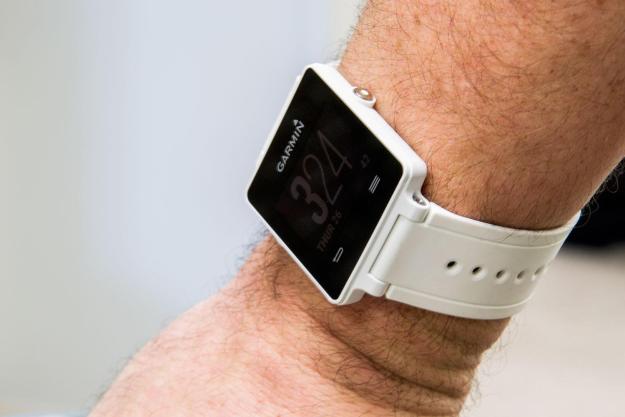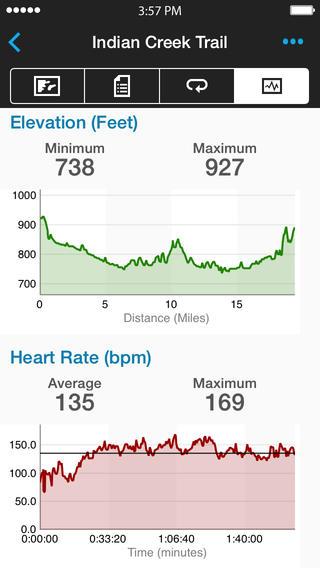
- On-board GPS and step tracking
- ANT+ sensor connectivity
- Waterproof to 5 ATM
- Smart Notifications (phone, text, email)
- Only one programmable alarm
- Sleep tracking lacks detail
- Menus can be complex
For years Garmin was known for creating high-tech GPS equipment that can look bulky, overly complicated, and on occasion just plain ugly. That changed in early 2014 when the company launched the Vívofit line of fitness trackers. These sleek bands featured a battery that lasted a year, a “move bar” to remind wearers to move when they’d been sitting too long, and sleep tracking. But they lacked GPS found in Garmin’s more specialized running or swimming watches.
Buy it now from:
Now Garmin is meeting athletes in the middle. With the Vívoactive, Garmin has blended the fitness-tracking features of the Vívofit with solid GPS tracking tech, all wrapped in a thin, lightweight, stylish, modern watch. Available for $250, or $300 bundled with a heart-rate monitor, it’s smart enough to be all the smartwatch most people need, and sporty enough to satisfy any athlete.
Features and design
At a distance, you might mistake the Vívoactive for the upcoming Apple Watch. That’s a good thing.
At 0.32 inches thick, the Vívoactive is a thin watch – especially in comparison to other GPS watches. It features a nearly square, 1.38-inch, 205 x 148 pixel color touch screen display and two buttons — one on each side of the watch’s face. The left button is for power and backlighting, and the right handles watch functions like starting and stopping activities or getting to the settings. Everything else is done by either swiping or tapping the touch screen. The traditional watchband is made of comfortable rubberized plastic, and you can pick one out in black or white.
Like a fitness band, the Vívoactive is capable of logging your steps taken, calories burned, distance travelled, and sleep. But it also includes full GPS tracking, and comes with apps for recording running, cycling, swimming, walking, golf (with downloadable courses), plus indoor (non-GPS) walking, running, and cycling. When connected to additional sensors (purchased separately) the Vívoactive can track heart rate, running cadence, ambient temperature, as well as speed and pedaling cadence for cycling.
When paired to a smartphone, the Vívoactive can display notifications for incoming calls, text, emails, and calendar items, right on your wrist. Responding to the notifications, however, requires accessing the phone. When you misplace your phone, you can also use the “find my phone” app to cause it to ring, making it easier to hunt down.
The biggest addition to the Vívoactive, however, is the IQ Connect Store, Garmin’s own app store. You can access it for free through the Garmin Connect smartphone app, and download apps and widgets that provide custom watch faces, additional sport tracking, and new ways of looking at the data. When new apps or widgets are created (we’re hoping for a surfing or skateboarding widget soon) they can be downloaded from the store and installed on the watch without ever plugging it into a computer. This makes the Vívoactive one of Garmin’s most customizable watches ever.
What’s in the box
The Vívoactive we tested included the watch and band, a USB charging-data cable with a proprietary magnetic connector, and a quick-start guide. For another $50, you get a Vívoactive Bundle that includes all the above, plus a soft strap heart-rate monitor.
Performance and use
After downloading the Garmin Connect app to our iPhone (also available for Android), getting the Vívoactive running was straight forward and well documented. The app asked us to create a profile on Garmin Connect, answer a few questions about gender, age, height and weight, and then attempted to pair with the watch via Bluetooth.
Make no mistake, while this watch looks simple on the outside, it is loaded with features and user options that can make it nearly as complex to operate as Garmin’s top-of-the-line fenix 3 watch. However, thanks to presets and defaults, it is possible to keep it simple as well.
Setting up basic fitness tracking requires using the Garmin Connect app to answer a few more questions in the “personal information” section, like average go-to-bed and wake up times. After setup, it will count steps, calories, and distance traveled, then automatically sync that info back to both the Garmin Connect smartphone app and website.
The Vívoactive seemed to do a fine job of tracking our general movements each day, and the “move bar” makes a nice reminder to get up and walk after sitting too long at the computer or on the couch. Garmin’s automatic daily step goals motivated us to improve each day, and we were mostly able to meet them.
But for tracking your sleep, the Vívoactive isn’t as adept as competitors like the Fitbit Charge, which tracks it automatically. On the Vívoactive, you must either setting the watch into sleep mode manually each night and wake it up each morning, or enter your sleep times into the app manually after the fact.
The biggest addition to the Vívoactive, however, is Garmin’s version of an app store called the IQ Connect Store.
Either way, the app displays so little detail, it’s hardly worth the trouble. While other trackers show a chart of time asleep, time restless, and time awake, the Garmin merely shows amounts of movement (low to high) over time. Knowing how much sleep we got was difficult when there was no way to tell which of the movements recorded were when we got up and out of bed, or when we simply rolled over roughly.
Learning which settings are controlled by the watch and which are set by the Garmin Connect app can also be tricky. Getting our Vívoactive set to our liking required a combination of the two, when we really would have preferred to do everything through the larger screen on a phone.
Fortunately, tracking activities couldn’t be easier. One press of the right-side button displays a screen of activity options. Just tap one to select it, then wait 15 to 30 seconds for the GPS to locate the satellites before it’s ready to go. You’ll see three of the metrics being recorded (all of which can be customized on the watch), and can tap the screen to see three more. Pressing the right button during an activity stops the activity, and an alert asks if the activity should be saved or discarded. The watch pushes all your results to the Garmin Connect app automatically, and you can even configure it to upload your achievements to the activity-tracking site Strava.com as well.
Connecting the Vívoactive to other (ANT+) sensors like a heart-rate monitor, cadence, or speed sensor was straight forward, and it remembers them between activities.
Our only real cause for frustration during an activity came from attempting to check the time. Short of stopping the activity altogether, or adding Time of Day as one of the data fields, we couldn’t find a way to get the time to display. After searching the manual (which is available on the Garmin Connect app) we finally discovered that to view the time during an activity you have to press and hold on the touch screen for approximately three seconds. Not exactly intuitive.
Battery
Garmin says one charge will power the watch up to three weeks in watch mode, and for 10 hours with the GPS running. That’s enough power for all but the most hardcore ultra marathoners and long-distance cyclists. We found that by using the GPS once or twice a day to track activities, we got an average of three to four days before we had to snap it into the magnetic charger.
One thing we didn’t notice was any kind of warning before the battery went dead – it just shuts down. A bit more warning would be nice.
Conclusion
After wearing the Vívoactive for two weeks, we still can’t really decide if this is the easiest to use GPS watch we’ve ever tested, or the most complex fitness tracking band. But that’s a good thing.
For athletes who have outgrown the simple step-tracking of a Garmin Vívofit or Fitbit Flex, but worry about the bulk of a GPS watch, the Vívoactive is a near perfect device. We could even argue that the Vívoactive’s smartwatch features alone are worth the price of admission. We love being able to turn off our ringer and get alerted to all important calls, texts, emails, and calendar notifications with a simple vibration on the wrist. It makes being always connected much less audibly painful. And while we find ourselves much more interested in GPS and ANT+ sensor data than steps, getting them recorded without thinking is a nice bonus.
Smartwatches like the Microsoft Band and LG G Watch R undoubtedly do more than the Vívoactive, but we don’t believe any of them do fitness and activity tracking as well, nor do they wrap it up in as cool a package as the Garmin Vívoactive.
Highs
- On-board GPS and step tracking
- ANT+ sensor connectivity
- Waterproof to 5 ATM
- Smart Notifications (phone, text, email)
Lows
- Only one programmable alarm
- Sleep tracking lacks detail
- Menus can be complex













